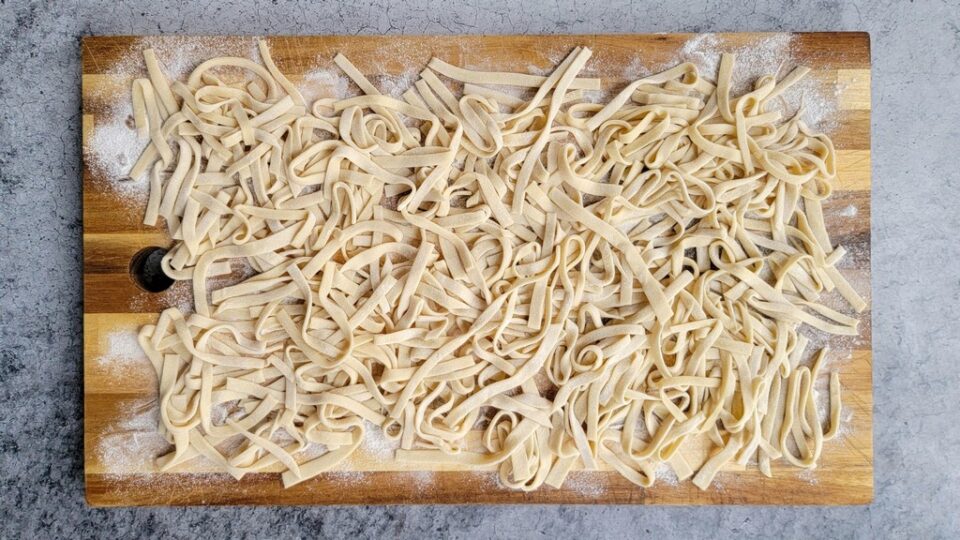Here is a recipe for homemade noodles that you can use for chicken noodle soup or a less familiar soup like Ash RestehWhich is a spring soup with a lot of leafy vegetables that celebrates the new Persian year. This noodle paste will also work for lasagna, but we advise you to double the ingredients to make enough for four layers in a 9 × 13 inches pan.

Homemade noodles, vegetables, beans and lentils
With the recipe below (300 grams or 2 1/3 of flour cups), you will have enough spaghetti for a large batch of soup, about 4 liters or 8-10 portions. You can resize the recipe as needed and we include instructions on how to store extra raw noodles. The development approach of the dough in this recipe, as well as the idea of using rice flour between the layers of pasta while cutting the tagliatelle, comes from This recipe for Persian noodles. It does not use the egg in the dough because the noodle should be soft, but I prefer a slightly chewing noodle, so I use eggs and water in the dough. You will find both options in the recipe below.
If you want to use full or high extraction flour instead of white flour for all purposes, you will probably need more liquid. This should be added slowly since the consistency of the ideal dough is hydrated enough to knead without “breaks”. Watch the video below and the photo gallery after the recipe for the consistency of the target dough and to how to launch and cut the dough.
https://www.youtube.com/watch?v=ikch9-c89rc

Bring the soup and lasagna to another level with fresh and tasty homemade noodles. This recipe is simple and can be reduced for more or less portions (double for a 9×13 “lasagna pan and you can try different flours for flavor, power and consistency.
Ingredients
In weight
- 300 grams of flour in all respects *
- 150-180 grams of water or 100-130 grams of water + 1 egg
- 6 grams of salt
In volume
- 2 1/3 of cups of flour in all respects *
- Take only from 2/3 to 3/4 cup of water or shoot 1/2 cup to cumulative 1/2 cup of water + 1 egg
- 1 teaspoon of salt
Baker percentage
Instructions
- Prepare a large pan or large cutting board with a sprinkling of rice flour. Semolina, the flour of all purposes or other flours are also fine.
- The consistency of the target dough for pasta is the lowest possible hydration without having dry or “cracking” pieces at the end of the dough process. Cracking I mean breaks on the surface of the dough that reveal dry flour.
- Add the ingredients to a bowl, holding some water. Mix the dough with a whisk or a Danish dough spatula until the liquid is distributed, then go to knead the dough into the bowl until all dry bits are incorporated. (You can use a mixer for stands or a food processor but regularly check the plot of the dough.)
- Transfer the dough to a clean work surface and knead for 1-2 minutes. Cover or bag the dough and let it rest 10 minutes. Knead the dough again for 1-2 minutes and add a small amount of water if it is not elastic. Cover or bag the dough a second time and let it rest 10 minutes. Knead again only a few times to confirm the softness, cover or bag the dough and let it rest 30-60 minutes.
- Unless you have a very large work surface (minimum of 24×24 inches), divide the dough into two for the launch into lots.
- With a rolling pin, roll out the dough to a thickness of 2-3 mm.
- Cut the sheet of pasta into 3-5-inch wide stripes; This will be the length of the noodles.
- Sprinkle the strips of pasta with rice flour on both sides, stacked and cut the noodles with a sharp knife. When they decide on the thickness, note that they will expand during the kitchen of about 150%.
- Raise and separate the noodles as you spread them on the infiated pan.
- Repeat the rolling and cutting the second half of the dough.
- When all the noodles are on the pan, dust with more flour and lift them and throw them to make sure they don’t stick to each other.
- Add the noodles to the soup at the end of the cooking process. They will only need 3-5 minutes to completely cook. You should test one to be sure that it is completely cooked and not yet mixed.
- If you have unused noodles, you can leave them on the pan to dry for a few hours, then transfer them to an airtight container and refrigerate. Use within three days. You can also freeze raw noodles on an infiatited pan (try to separate them as much as possible), then transfer them to a container or a sealed bag. Use within three months.
Notes
* You can use different flours (whole wheat, high extraction) and different varieties of wheat (e.g. durum, spelling, hard white spring wheat) for your noodles. In most replacements, you will need more water to hydrate the dough. The flour used in this recipe is the flour for all biological purposes of Broadtopia, which has a protein of 10-10.5%. The flours with more proteins or more bran and germ tend to be more absorbent. Any einkorn and white -written flour is probably less absorbent.


